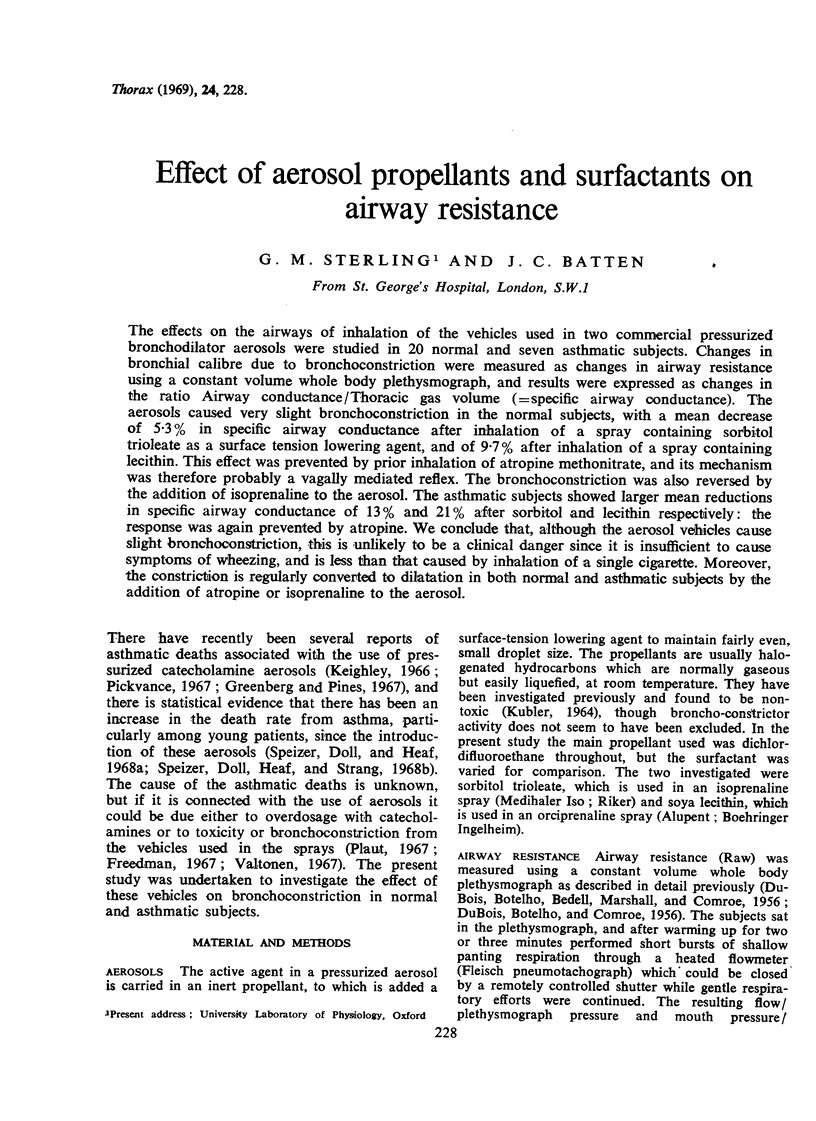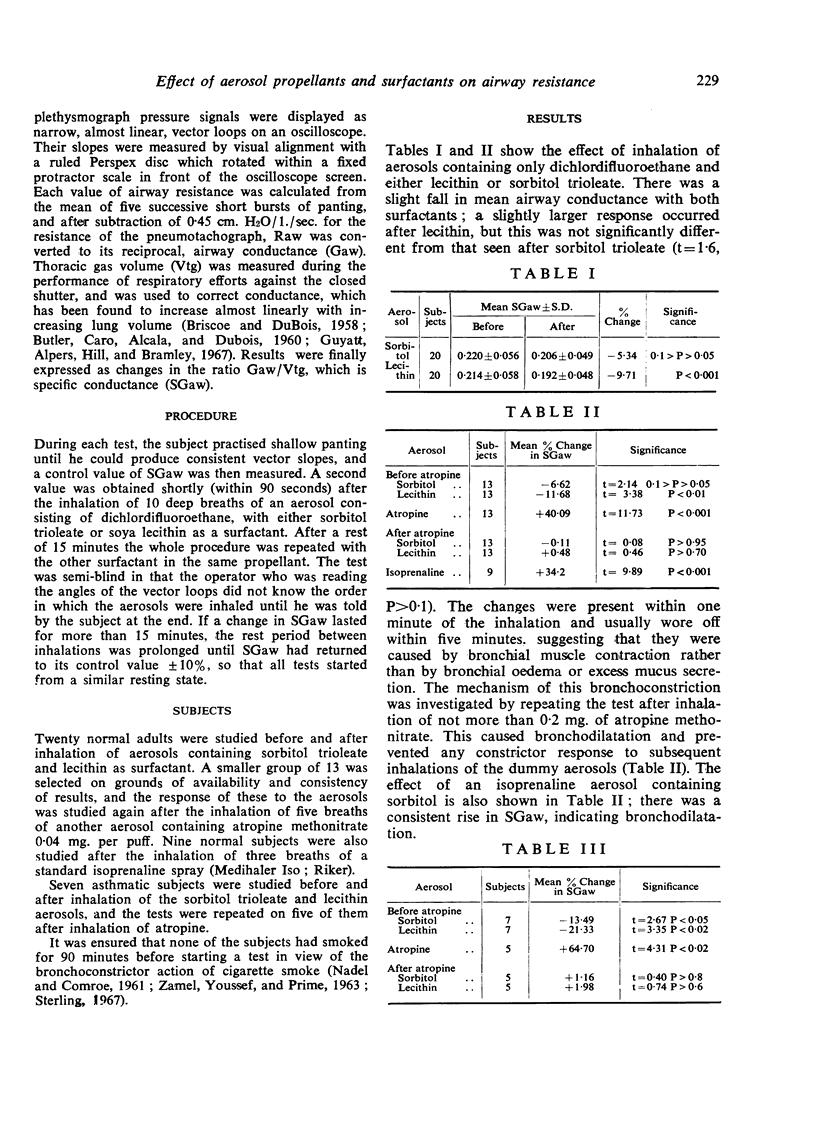Abstract
The effects on the airways of inhalation of the vehicles used in two commercial pressurized bronchodilator aerosols were studied in 20 normal and seven asthmatic subjects. Changes in bronchial calibre due to bronchoconstriction were measured as changes in airway resistance using a constant volume whole body plethysmograph, and results were expressed as changes in the ratio Airway conductance/Thoracic gas volume (=specific airway conductance). The aerosols caused very slight bronchoconstriction in the normal subjects, with a mean decrease of 5·3% in specific airway conductance after inhalation of a spray containing sorbitol trioleate as a surface tension lowering agent, and of 9·7% after inhalation of a spray containing lecithin. This effect was prevented by prior inhalation of atropine methonitrate, and its mechanism was therefore probably a vagally mediated reflex. The bronchoconstriction was also reversed by the addition of isoprenaline to the aerosol. The asthmatic subjects showed larger mean reductions in specific airway conductance of 13% and 21% after sorbitol and lecithin respectively: the response was again prevented by atropine. We conclude that, although the aerosol vehicles cause slight bronchoconstriction, this is unlikely to be a clinical danger since it is insufficient to cause symptoms of wheezing, and is less than that caused by inhalation of a single cigarette. Moreover, the constriction is regularly converted to dilatation in both normal and asthmatic subjects by the addition of atropine or isoprenaline to the aerosol.
Full text
PDF



Selected References
These references are in PubMed. This may not be the complete list of references from this article.
- ALTOUNYAN R. E. VARIATION OF DRUG ACTION ON AIRWAY OBSTRUCTION IN MAN. Thorax. 1964 Sep;19:406–415. doi: 10.1136/thx.19.5.406. [DOI] [PMC free article] [PubMed] [Google Scholar]
- BRISCOE W. A., DUBOIS A. B. The relationship between airway resistance, airway conductance and lung volume in subjects of different age and body size. J Clin Invest. 1958 Sep;37(9):1279–1285. doi: 10.1172/JCI103715. [DOI] [PMC free article] [PubMed] [Google Scholar]
- BUTLER J., CARO C. G., ALCALA R., DUBOIS A. B. Physiological factors affecting airway resistance in normal subjects and in patients with obstructive respiratory disease. J Clin Invest. 1960 Apr;39:584–591. doi: 10.1172/JCI104071. [DOI] [PMC free article] [PubMed] [Google Scholar]
- CHAMBERLAIN D. A., MUIR D. C., KENNEDY K. P. Atropine methonitrate and isoprenaline in bronchial asthma. Lancet. 1962 Nov 17;2(7264):1019–1021. doi: 10.1016/s0140-6736(62)92704-6. [DOI] [PubMed] [Google Scholar]
- DUBOIS A. B., BOTELHO S. Y., BEDELL G. N., MARSHALL R., COMROE J. H., Jr A rapid plethysmographic method for measuring thoracic gas volume: a comparison with a nitrogen washout method for measuring functional residual capacity in normal subjects. J Clin Invest. 1956 Mar;35(3):322–326. doi: 10.1172/JCI103281. [DOI] [PMC free article] [PubMed] [Google Scholar]
- DUBOIS A. B., BOTELHO S. Y., COMROE J. H., Jr A new method for measuring airway resistance in man using a body plethysmograph: values in normal subjects and in patients with respiratory disease. J Clin Invest. 1956 Mar;35(3):327–335. doi: 10.1172/JCI103282. [DOI] [PMC free article] [PubMed] [Google Scholar]
- Guyatt A. R., Alpers J. H., Hill I. D., Bramley A. C. Variability of plethysmographic measurements of airways resistance in man. J Appl Physiol. 1967 Feb;22(2):383–389. doi: 10.1152/jappl.1967.22.2.383. [DOI] [PubMed] [Google Scholar]
- Keighley J. F. Iatrogenic asthma associated with adrenergic aerosols. Ann Intern Med. 1966 Nov;65(5):985–995. doi: 10.7326/0003-4819-65-5-985. [DOI] [PubMed] [Google Scholar]
- LLOYD T. C., Jr, WRIGHT G. W. Evaluation of methods used in detecting changes of airway resistance in man. Am Rev Respir Dis. 1963 Apr;87:529–537. doi: 10.1164/arrd.1963.87.4.529. [DOI] [PubMed] [Google Scholar]
- NADEL J. A., COMROE J. H., Jr Acute effects of inhalation of cigarette smoke on airway conductance. J Appl Physiol. 1961 Jul;16:713–716. doi: 10.1152/jappl.1961.16.4.713. [DOI] [PubMed] [Google Scholar]
- NADEL J. A., SALEM H., TAMPLIN B., TOKIWA Y. MECHANISM OF BRONCHOCONSTRICTION DURING INHALATION OF SULFUR DIOXIDE. J Appl Physiol. 1965 Jan;20:164–167. doi: 10.1152/jappl.1965.20.1.164. [DOI] [PubMed] [Google Scholar]
- Speizer F. E., Doll R., Heaf P. Observations on recent increase in mortality from asthma. Br Med J. 1968 Feb 10;1(5588):335–339. doi: 10.1136/bmj.1.5588.335. [DOI] [PMC free article] [PubMed] [Google Scholar]
- Speizer F. E., Doll R., Heaf P., Strang L. B. Investigation into use of drugs preceding death from asthma. Br Med J. 1968 Feb 10;1(5588):339–343. doi: 10.1136/bmj.1.5588.339. [DOI] [PMC free article] [PubMed] [Google Scholar]
- Sterling G. M. Mechanism of bronchoconstriction caused by cigarette smoking. Br Med J. 1967 Jul 29;3(5560):275–277. doi: 10.1136/bmj.3.5560.275. [DOI] [PMC free article] [PubMed] [Google Scholar]
- WIDDICOMBE J. G., KENT D. C., NADEL J. A. Mechanism of bronchoconstriction during inhalation of dust. J Appl Physiol. 1962 Jul;17:613–616. doi: 10.1152/jappl.1962.17.4.613. [DOI] [PubMed] [Google Scholar]
- ZAMEL N., YOUSSEF H. H., PRIME F. J. Airway resistance and peak expiratory flow-rate in smokers and non-smokers. Lancet. 1963 Jun 8;1(7293):1237–1238. doi: 10.1016/s0140-6736(63)91866-x. [DOI] [PubMed] [Google Scholar]


